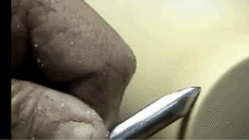I need to turn 10 Shaker style knobs that should at least visually be identical. I have no experience spindle turning but have done some test knobs. It's not difficult to turn the knobs but, since they need to be identical, I thought I would make a template to match each knob to.
What's the best way to do this?
1. Use a contour gauge to create the shape and they match the knobs to the contour gauge.
2. Use the contour gauge, but only to create a wood template to which each knob would be matched.
What's the best way to do this?
1. Use a contour gauge to create the shape and they match the knobs to the contour gauge.
2. Use the contour gauge, but only to create a wood template to which each knob would be matched.

